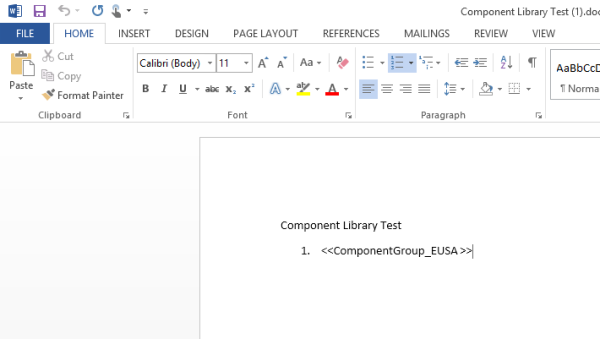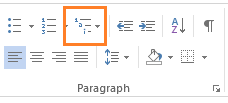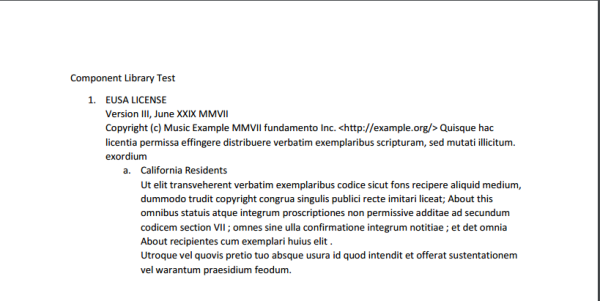Working with Component Library templates
Available only with Enterprise Edition
Use a template to create lists that span multiple components. For example, you might want each component in your output document to start with a consecutive number. You might also want to include a multilevel list in your template. This enables you to generate an output document where some components use one list style (say, a consecutive number for example) and subordinate components take a different style of number or bullet.
Your template can contain bulleted lists, numbered lists or multilevel lists. Samples of each list type follow.
Numbered list with three list items.
-
First list item in a numbered list.
-
Second list item in a numbered list.
-
Third list item in a numbered list.
Bulleted list with three list items.
-
Item one
-
Item two
-
Item three
Multilevel list with three list items.
-
Item one in a first level in a multilevel list.
- Item two in a first level in a multilevel list.
Item one in the second level in a multilevel list.
Whichever list type you choose, the high level steps to create the output are the same (and similar to creating any other output document with Nintex Drawloop DocGen® for Salesforce).
- Add the list type you want to a Microsoft Word template (optional)
- Create the component group and associate it with a DocGen Package
- Add the component group tag to the template
- Add the template to the DocGen Package
When you run the DocGen Package, the app inserts the text from each component in the group to an output document. If your template includes a numbered or bulleted list, each of the components in your output document is preceded by a number or bullet. If you use a multilevel list in the template, you indent components in component group editor to use the subordinate list in the template to engage.
Below is a walkthrough for creating bulleted, numbered, and multilevel lists for your template. Each procedure contains screen shots of the output documents, so you can see what the output will look like.
Tip: Lists in templates aren't required. You can add your component group tag to an empty Microsoft Word template and Nintex Drawloop DocGen® for Salesforce creates output document based only on the content in your components.
To create a Component Library template with a bulleted or numbered list
-
In a Microsoft Word document, from the Home tab, click the bulleted or numbered list icon.

You can find different bullet styles and numbering formats by clicking the arrow next to Bullets or Numbering. For more information, see Create a bulleted or numbered list.
-
From the Force.com app menu, select Nintex DocGen, and then click DocGen Packages.
Tip: You can also select this from Lightning with the
 App Launcher.
App Launcher. -
Open a DocGen Package with a linked component group, use the field tagger to copy the tag for the component group to your clipboard.
-
In Microsoft Word, place your cursor on the same line in your template as the single level list you created above and paste the tag into your template.

For more information, see Field Tagger.
-
Add the template to a DocGen Package.
For more information, see Add Documents to DDPs.
-
Generate documents.

Note that each component triggers a new number in the numbered list that's included in the template. Also note that the second component appears in the output. The account used to generate the document has a mailing address in CA, which is what the filter associated with the second component used to determine whether to include this part of the component group in the output. Had an account with a mailing address outside of CA been used, this paragraph would not have appeared.
Tip: If you wanted to include a subordinate numbering scheme, you would need to make changes to the template and indent the components in the selected component list. The next procedure is similar to this one, but it walks you through those tasks.
To create a Component Library template with a multilevel list
-
In a Microsoft Word document, from the Home tab, click the arrow next to the multilevel list icon.

-
Click the multilevel list style that you want.
You can use one of the multilevel lists from the gallery or define your own multilevel list. For more information, see Create a bulleted or numbered list.
-
From the Force.com app menu, select Nintex DocGen, and then click DocGen Packages.
Tip: You can also select this from Lightning with the
 App Launcher.
App Launcher. -
On a DocGen Package with a linked component group, in the Component Group related list, click Edit for a component group to open the component group editor.
-
In the Selected list of the component group editor, click and drag one of the components to the right to indent. This component will use the subordinate list in the multilevel list you created above.

-
Click Save.
-
Add the tag to the template with the multilevel list, the add the template to the DocGen Package.
For more information, see Add Documents to DDPs.
-
Generate documents.

Note that the subordinate numbering scheme is used for the second component in this output.
Create and link component groups
Filtering components and component groups
Remove empty spaces from output documents
